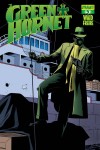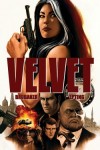I just can’t muster the hubris to do a Top 10 list. Lists are subject to the tastes of the reviewer(s). One person’s top 10 list doesn’t necessarily mean anything. And, you know, Buzzfeed. Instead, I’ll present a list of comics that made me happy in 2013, with an emphasis on things that might have a slightly lower profile. (You should already have heard of things like Saga and Daredevil, right?)
And so, in no particular order, the 2013 Comics Happy List
Lazarus (Image) by Greg Rucka and Michael Lark

Excellent world building, a bit of futurism and betrayals at a brisk pace are how this book rolls. Michael Lark’s work is excellent – as always. Just a really nice comic.
Marshall Law: The Deluxe Edition (DC) by Pat Mills and Kevin O’Neill

Marshall Law bills himself as a hero killer. In a world where superheroes were weaponized as a military project, the Marshall, who really hates capes, tries to clean up there messes. This is a pitch black satire. Not an affectionate wink toward superheroes, this series shreds the tropes with malice and contempt. It was quite the shocking series when it came out and it still goes a bit further than you might expect in certain places.
If you’re a fan of The Boys, it’s reasonable to say this is The Boys’ grandfather and it’s well worth checking out. If you like your satire vicious, it’s a winner. If you hold up superhero tropes as comforting things in troubled times, back away slowly.
Superior Foes of Spider-Man (Marvel) by Nick Spencer and Steve Lieber

No mistake about it, these have been a couple good years for slightly goofy comics. They aren’t all tearing up the sales charts, but they’re a lot more sustainable than they used to be. DC’s Harley Quinn relaunch certainly reminds me of the Hawkeye/Superior Foes tone, so we might have a sub-genre on our hands.
Superior Foes is my favorite of the off-kilter mainstream superhero comics… even if it’s off-kilter supervillains.
Mark Waid’s The Green Hornet (Dynamite) by Mark Waid and Daniel Indro/ Ronilson Freire

This is a fairly rare thing for The Hornet. The comic is set in the heyday of the radio show. It’s the original Green Hornet. Not an updating. Not his son or grandson. I don’t know that anyone has gone back to the original version since the old ‘40s comics.
As the series starts, The Hornet has gotten a bit full of himself and his hubris takes him on an unpleasant and embarrassing ride as he tries to navigate political manipulations and figure out what’s up with these German spies. This could well be the definitive Green Hornet comic and it’s flying far below the radar.
The Sixth Gun (Oni) by Cullen Bunn and Brian Hurtt

The Sixth Gun wins with strong characterization and an expanding cast of characters all of whom are vying for control of the apocalyptic artifacts with many of them having very different designs on their use. It’s a comic that isn’t afraid to get strange and creepy. As dark as it gets, Brian Hurtt’s art has a simple, clean and deceptively light look and feel to it, which serves to ground things and make them even more disturbing. A combination of art and story that fits like a glove, even when you might not expect it to.
This is a comic I wait for the tpbs for and devour them in one sitting. If you haven’t been reading it, go back and start with Volume 1. It’s highly recommended and hasn’t slowed down through Volume 5.
Archer & Armstrong (Valiant) by Fred Van Lente and Emanuela Lupacchino/Khari Evans

Another slightly goofy comic, A&A is a not-quite superhero (but close) romp that sends up right wing conspiracies as an immortal drunkard and teenage assassin (raised by an overtly fundamentalist Christian cult that’s was fronting for a larger conspiracy) navigate a landscape of ancient “sects” competing for pieces to an even more ancient artifact.
How goofy is it? The sect representing Wall Street is “The 1%” and they wear golden bull masks. You’ve got a sect of Nazi llamas. You’ve got the “Master Builders” sect who look a bit Masonic. While not a sect, you’ve got a foray through the Bermuda Triangle with a “General Redacted” who’s put the grey aliens from Area 51 to work. Which is to say, it’s very goofy, yet it’s still telling a story in a relative straight line, which can have a serious moment or two hidden among the more prevalent sarcasm.
Trillium (DC/Vertigo) by Jeff Lemire

Part of the craftsmanship of Trillium Lemire’s use of flipbook format. The first issue is in two halves. Each from the perspective of one of the couple who are the main characters, entering the situation in their own time period. Finish one half, flip it over, read the other perspective. It finishes in the same place. The pacing and production, absolutely precise. In the current issue (#5), a similar structure exists. The top and bottom halves of the pages are their own narratives… except they’re upside down from each other. Read the top half through, flip the book, read the other half. Again, the narratives correspond and lead to the same place. The structure is as well done as you’ll see.
I also have no idea how this is going to work in a collected edition, but Lemire is working the monthly format with everything he’s got.
The story itself, which touches on colonialism and fear of the unknown, would work on its own… but the presentation really puts it over the top.
Afterlife With Archie (Archie) by Roberto Aguirre-Sacasa and Francesco Francavilla

That’s all you really need to know about this comic. It’s Archie Vs. Zombies where suspension of disbelief isn’t an issue and the creepy mood builds organically. Well… it’s also drawn by Francavilla, who can do no wrong these days.
Velvet (Image) by Ed Brubaker and Steve Epting

Not to be underplayed, there’s subtle similarity to the plot structure. Much as the Winter Soldier came out of Cap’s past. The titular Velvet finds herself drawn out of retirement (from the field) as a conspiracy from her past threatens to overtake her.
This is a fine action/spy tale, still a bit early in the game, but very satisfying two issues in.
Astro City (DC/Vertigo) by Kurt Busiek and Brent Anderson with Alex Ross

Astro City is a celebration of superheroes. Initially, it was a celebration of the Silver Age of comics, but it’s evolved a bit past that, even if that’s where its heart may still lie. Sometimes it focuses on the heroes. Sometimes on the civilians in their wake. A recent arc was on the heroes’ employees.
Astro City plays with archetypal heroes, giving them their own world and slowly revealing the mysteries of their pasts and their relationships. It doesn’t so much have a predominant tone, so much as a tendency to provoke a sense of wonder as you read it. In many ways it is the anti-Marshall Law.
Were these the only comics that made me happy in 2013? No, but it’s a good enough place to start. And it’s not like you don’t have enough lists to pick from this time of year.








Actually, the Marshal (sic) Law book does not collect the complete set of comics. It’s missing at least three different miniseries.
Huh… Todd, Pere Perez drew most of those Archer & Armstrong issues. I think he’s worthy of a mention. Just sayin’. ;)
Comments are closed.